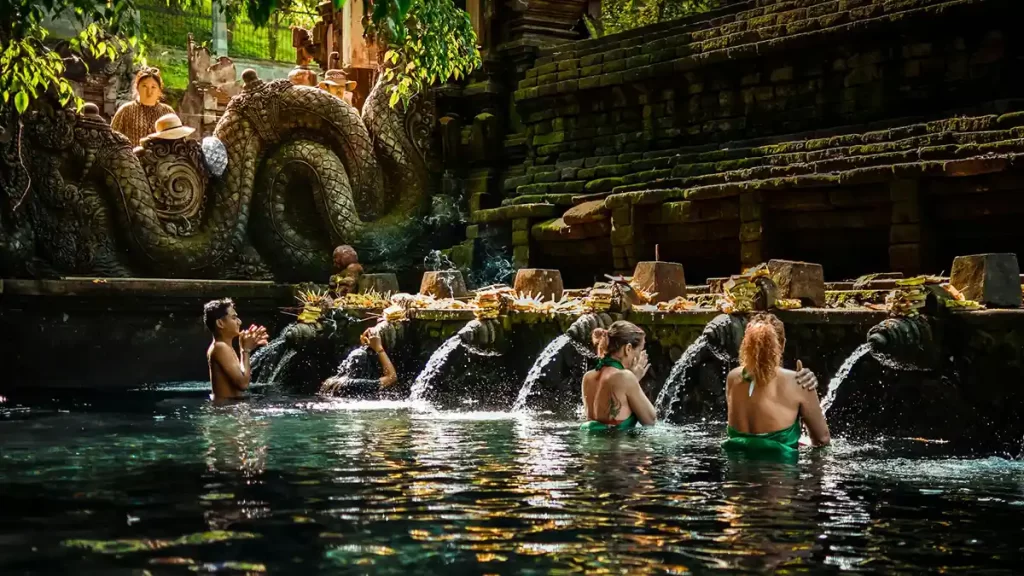Tirta Empul Temple, located near the town of Tampaksiring in Bali, Indonesia, is a revered Hindu Balinese water temple. Known for its sacred spring water, believed to possess purifying and healing properties, Tirta Empul draws both devout locals and curious tourists. In this opportunity, we’ll delve into the rich history, significance, and rituals associated with Tirta Empul, painting a vivid picture of this enchanting site.
Origins and Significance
Tirta Empul, founded in 926 A.D., remains an active place of worship and a vital part of Balinese culture. The temple is dedicated to Vishnu, the Hindu God of water, symbolizing the life-giving and purifying aspects of the element. The name “Tirta Empul” translates to “water gushing from the earth”, emphasizing its role as a holy spring.
According to legend, the sacred springs were created by the god Indra, who pierced the earth to create a source of holy water to revive his poisoned troops. This myth imbues the site with a sense of divine intervention and spiritual significance, making it a place where devotees seek physical and spiritual cleansing.
Main Attractions: The Holy Springs
At the heart of Tirta Empul are its holy springs, which are considered blessed and capable of purifying those who bathe in them. These springs flow into a series of pools where visitors can partake in purification rituals known as Melukat. The ritual involves a specific sequence of steps, starting with prayers and offerings, followed by submerging oneself under each of the fountains to cleanse the body and spirit.
The belief in the healing properties of the water draws people from all walks of life. Some seek relief from ailments, while others come for spiritual rejuvenation. The serene atmosphere, coupled with the rhythmic sound of flowing water, creates a deeply meditative experience for all who visit.
Read more: Experience Authentic Bali: 6 Must-Visit Traditional Villages
The Layout of Temple Complex
Located in the village of Manukaya, near Ubud, Tirta Empul offers captivating views and a glimpse into Bali’s rich cultural heritage. The temple complex, known as the petirtaan (bathing center), is vast, requiring at least 30 minutes to explore fully. Before entering, visitors must wear a sarong, which is available at the entrance, as a sign of respect for the sacred site.
The complex is divided into three main courtyards: the outer courtyard (Jaba Sisi), the central courtyard, and the inner courtyard (Jeroen). Each section holds its own significance and beauty, inviting exploration and reflection.
Guide to Exploring the Temple
As you pass through the candi bentar (Balinese gate) into the outer courtyard, you are greeted by the tranquil ambiance and intricate carvings that adorn the temple structures. The outer courtyard is a space for visitors to prepare themselves before entering the more sacred areas.
The central courtyard is guarded by impressive statues of Dwarapala, the temple guardians, adding a sense of majesty and protection to the space. Here, you can admire beautifully carved shrines dedicated to various deities such as Shiva, Vishnu, Brahma, and Indra, along with a shrine for Mount Batur, one of Bali’s most revered volcanoes.
The inner courtyard houses the sacred springs and pools where the purification rituals take place. The crystal-clear water, flowing continuously from the earth, serves as a reminder of the temple’s divine origins. The sight of devotees engaged in the Melukat ritual, with their eyes closed in prayer and water cascading over them, is profoundly moving.
How to Get To Tirta Empul Temple
Tirta Empul Temple is located in the village of Manukaya, Tampaksiring, approximately 20 kilometers northeast of Ubud. The most convenient way to reach the temple is by hiring a car or scooter, which allows for flexibility and the opportunity to explore the scenic routes of Bali. Alternatively, you can join a guided tour that includes transportation and often provides valuable insights into the temple’s history and rituals.
From Ubud, the drive to Tirta Empul takes around 30-40 minutes. If you’re coming from the popular tourist hub of Kuta, expect a journey of about 1.5 to 2 hours, depending on traffic. Public transportation options are limited, so renting a vehicle or taking a tour is recommended for the most seamless experience.
A few Things to Keep in Mind as A Visitor
- Dress Code: As a place of worship, Tirta Empul requires visitors to dress modestly. Sarongs and sashes are provided at the entrance, and it is essential to wear them correctly. Shoulders should be covered, and it is advisable to avoid revealing clothing.
- Respectful Behavior: Maintain a respectful demeanor throughout your visit. Avoid loud conversations and be mindful of ongoing rituals and ceremonies. Photography is allowed, but always ask for permission before taking pictures of people, especially those engaged in rituals.
- Purification Ritual Etiquette: If you choose to participate in the Melukat ritual, observe the proper sequence of steps and follow the guidance of local practitioners. It’s customary to start with prayers and offerings at the temple before entering the water. Keep in mind that the ritual is a spiritual practice, and conduct yourself with the appropriate reverence.
- Safety: The temple grounds can be slippery, especially around the pools. Walk carefully and use the handrails where available. If you have any medical conditions, consult with a healthcare professional before participating in the purification ritual.
- Environmental Awareness: Help preserve the beauty and sanctity of Tirta Empul by not littering and respecting the natural environment. Dispose of any waste properly and avoid touching or disturbing the temple structures and sacred water sources.
How does it feel experiencing the purification rituals at Tirta Empul Temple?
For many visitors, a trip to Tirta Empul is a deeply personal and transformative experience. The combination of historical grandeur, spiritual energy, and natural beauty creates an atmosphere that is both humbling and inspiring. The sound of traditional Balinese music often fills the air, enhancing the sensory experience.
As you stand before the temple, a tinge of apprehension bubbling in your stomach. This purification ritual, a cornerstone of Balinese tradition, is both mysterious and inviting. As the ceremony unfolds, a sense of peace will wash over you, replacing the initial nervousness. With each prayer and offering, you feel a deep connection to the land and the Balinese people. It’s as if the holy water itself carries the wisdom of generations, washing away negativity and leaving you feeling clear and centered.
The vibrant offerings, colorful flowers, and fragrant incense create a sensory experience that lingers long after the ceremony is complete. You leave feeling not just cleansed, but deeply touched by the enduring reverence for this sacred place.
Tirta Empul Temple stands as a proof to Bali’s ever living rich cultural and spiritual heritage. Its sacred waters continue to draw pilgrims and tourists alike, offering a space for purification, reflection, and connection. Whether you seek spiritual healing or simply wish to immerse yourself in the beauty and history of Bali, a visit to Tirta Empul is an experience that transcends borders and time.
The allure of Tirta Empul lies not only in its historical significance and architectural beauty but also in the palpable sense of peace and reverence that pervades the site. It is a place where the past and present converge, where the divine meets the earthly, and where the simple act of bathing in sacred waters can become a profound journey of the soul.
Read more: Essentials 20 Do’s and Don’ts in Bali For Tourists and Travelers
Frequently Asked Questions about Tirta Empul Temple
1. What is the significance of Tirta Empul Temple?
Tirta Empul Temple holds deep significance for Balinese Hindus. It’s a revered water temple complex centered around sacred natural springs believed to possess cleansing properties. Devotees come to bathe in these holy waters and perform purification rituals, seeking spiritual renewal.
2. What Should I Wear When Visiting Tirta Empul Temple?
As with most Balinese Hindu temples, there’s a dress code for Tirta Empul. You’ll need to cover your lower body with a sarong, which can be rented for a small fee at the entrance if you don’t have one. For your upper body, a T-shirt or shirt is appropriate. Headscarves (udeng) are optional.
3. How much time should I allow to explore Tirta Empul Temple?
Plan to spend at least 30 minutes to an hour exploring Tirta Empul. The temple complex is quite large with various courtyards, shrines, and the sacred purification springs. If you wish to participate in the purification bathing rituals and soak in the atmosphere, factor in additional time.
4. Can I get to Tirta Empul Temple by public transportation?
Public transportation options to Tirta Empul Temple are limited. The most convenient ways to get there are by taxi or motorbike rentals. Many tours from Ubud also include Tirta Empul as part of their itinerary.











